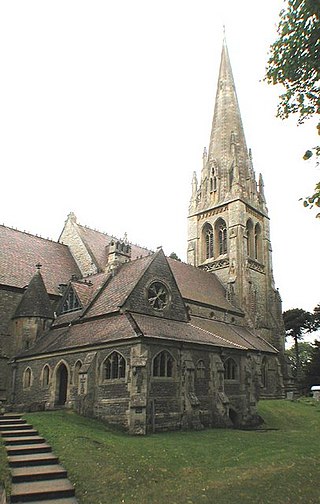Richmond is a town in south-west London, 8.2 miles (13.2 km) west-southwest of Charing Cross. It stands on the River Thames, and features many parks and open spaces, including Richmond Park, and many protected conservation areas, which include much of Richmond Hill. A specific Act of Parliament protects the scenic view of the River Thames from Richmond.
Samuel Sanders Teulon was an English Gothic Revival architect, noted for his use of polychrome brickwork and the complex planning of his buildings.

Richmond Green is a recreation area near the centre of Richmond, a town of about 20,000 inhabitants situated in south-west London. Owned by the Crown Estate, it is leased to the London Borough of Richmond upon Thames. The Green, which has been described as "one of the most beautiful urban greens surviving anywhere in England", is roughly square in shape and its open grassland, framed with broadleaf trees, extends to roughly twelve acres. On the north-east side there is also a smaller open space called Little Green. Richmond Green and Little Green are overlooked by a mixture of period townhouses, historic buildings and municipal and commercial establishments including the Richmond Lending Library and Richmond Theatre.
Benjamin Ferrey FSA FRIBA was an English architect who worked mostly in the Gothic Revival.

Henry Woodyer (1816–1896) was an English architect, a pupil of William Butterfield and a disciple of A. W. N. Pugin and the Ecclesiologists.

As of 2011 there were 102 listed buildings and structures in the English borough of Crawley, West Sussex. Two others have subsequently gained listed status. The Borough of Crawley is based on the town of the same name, located approximately halfway between London and Brighton. Although Crawley expanded substantially after World War II when it was designated a New Town by an Act of Parliament, many older buildings remain.

Richmond Place, now known as Asgill House, is a Grade I listed 18th-century Palladian villa on Old Palace Lane in Richmond, London, overlooking the River Thames. The house is on the former site of the river frontage and later the brewhouse for the medieval and Tudor Richmond Palace. It is 8 miles (13 km) from Charing Cross and was built in 1757–58 by Sir Robert Taylor as a summer and weekend parkland villa beside the river for the merchant banker Sir Charles Asgill, who was Lord Mayor of London in 1757–58. It has been described as "among the last villas of importance to be erected on the banks of the Thames".

There are 24 Grade I listed buildings in the city of Brighton and Hove, England. The city, on the English Channel coast approximately 52 miles (84 km) south of London, was formed as a unitary authority in 1997 by the merger of the neighbouring towns of Brighton and Hove. Queen Elizabeth II granted city status in 2000.

St Anne's Church, Kew, is a parish church in Kew in the London Borough of Richmond upon Thames. The building, which dates from 1714 and is Grade II* listed, forms the central focus of Kew Green. The raised churchyard, which is on three sides of the church, has two Grade II* listed monuments – the tombs of the artists Johan Zoffany and Thomas Gainsborough. The French Impressionist painter Camille Pissarro (1830–1903), who stayed in 1892 at 10 Kew Green, portrayed St Anne's in his painting Church at Kew (1892).

Kelly & Birchall, a partnership between Edward Birchall and John Kelly (1840–1904), was an architectural practice based in Leeds, England, from 1886 to 1904 and specialising in churches in the Italianate and Gothic Revival styles.
Leslie Gooday OBE (1921–2013) was a British architect.
Captain William Charles Braxton Sinclair FRIBA was a British architect who worked in the United Kingdom and in Burma, where he was a captain in the Royal Engineers. He was also a local historian.

Twickenham War Memorial, in Radnor Gardens, Twickenham, London, commemorates the men of the district of Twickenham who died in the First World War. After 1945, the memorial was updated to recognise casualties from the Second World War. The memorial was commissioned by Twickenham Urban District Council in 1921. It was designed by the sculptor Mortimer Brown, and is Brown's only significant public work. The memorial is unusual for its representation of a jubilant soldier returning home. It became a Grade II* listed structure in 2017.

John Dixon Butler was a British architect and surveyor who had a long, professional association with London's Metropolitan Police. During his 25-year career with the police, he completed the designs and alterations to around 200 police buildings, including ten courts; as of 2022, about 58 of his buildings survive. Historic England describes him as "one of the most accomplished Metropolitan Police architects" and have included around 25 of his buildings on the National Historic List of England and Wales.

Queen's Road is a street in Richmond in the London Borough of Richmond upon Thames, running southwestwards from Sheen Road up Richmond Hill until it meets the street of that name by the former Star and Garter Home. It forms a section of the B353 road and runs roughly parallel to the edge of Richmond Park. Pesthouse Common, now an area of open space but previously the site of a plague house, is located near the northern end of the street.














